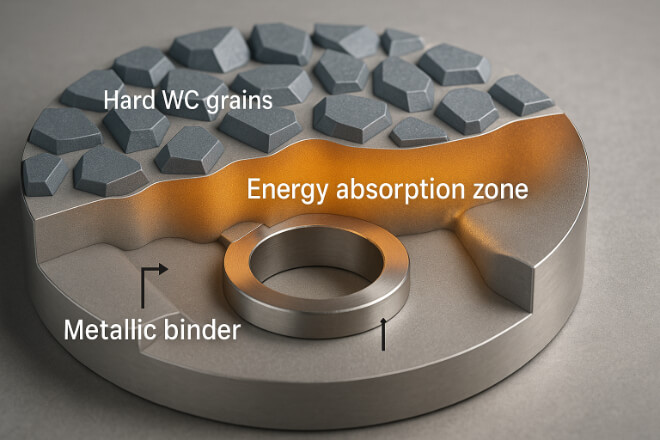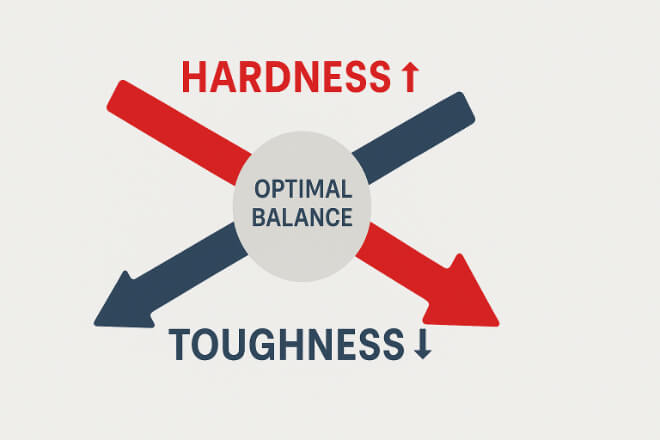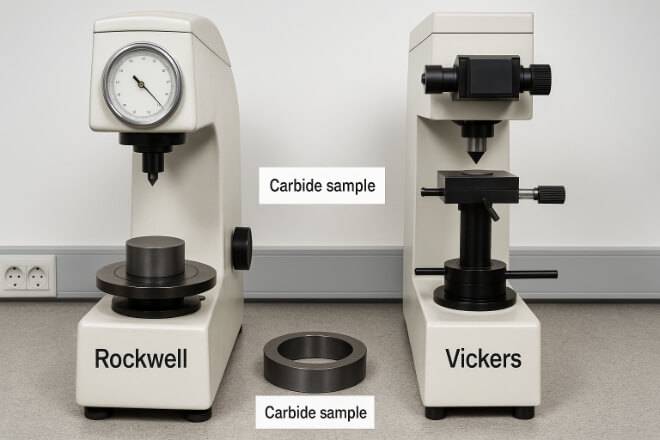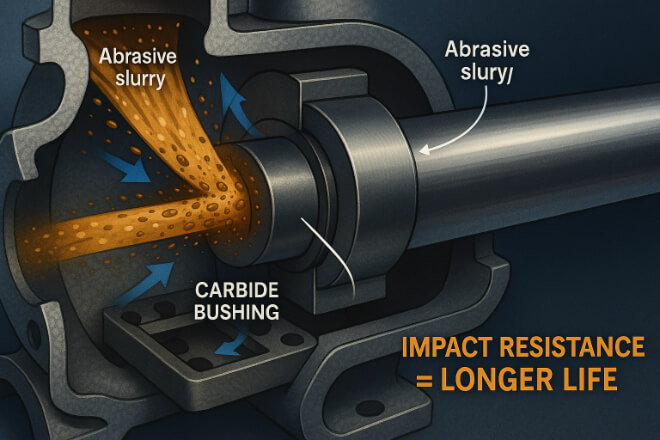When it comes to mechanical parts that face constant wear, pressure, and friction, بطانات كربيد التنغستن are among the most trusted materials.
They are used in pumps, compressors, turbines, and other high-load systems where failure is not an option.
Their outstanding durability comes mainly from two material properties — صلابة و صلابة. Both are vital, but they behave differently and often pull in opposite directions.
This article helps you understand what hardness and toughness mean, how they influence the performance of tungsten carbide bushings, and how the right balance leads to long-lasting reliability in harsh industrial conditions.
What Is Hardness?
صلابة measures how well a material resists deformation, scratching, or indentation. In simple words, it tells us how difficult it is to cut or wear the surface.
Tungsten carbide is known for its exceptional hardness, which ranges between 88–92 HRA, making it one of the hardest materials used in engineering — second only to diamond.
This hardness allows carbide bushings to:
Resist wear in abrasive environments
Keep tight clearances even under pressure
Maintain shape and surface quality over long operating hours
1). Typical Hardness Comparison
| مادة | الصلابة (HRA) | Relative Wear Resistance |
|---|---|---|
| Bronze | 45–60 | قليل |
| الفولاذ المقسى | 65–75 | معتدل |
| كربيد التنغستن | 88–92 | عالية جدًا |
The higher the hardness, the more resistant the bushing is to scratches, grooves, and deformation caused by sliding contact with shafts or abrasive particles.
What Is Toughness?

صلابة is the ability of a material to absorb energy and resist cracking or breaking under impact or stress.
While hardness prevents wear, toughness prevents brittle failure.
A material that is very hard but not tough can crack easily under vibration or shock loads.
Toughness depends on:
The type and amount of binder (Cobalt or Nickel)
The grain size of tungsten carbide particles
The sintering quality and المسامية level
Tungsten carbide bushings achieve toughness through their composite structure — hard WC grains bonded by a softer, ductile metal binder that absorbs impact energy.
التوازن بين الصلابة والمتانة

In material science, صلابة و صلابة are often in conflict. Increasing hardness (by reducing binder or grain size) usually lowers toughness.
The best tungsten carbide bushings are those that strike the right balance between the two — hard enough to resist wear, but tough enough to resist cracking.
1). Typical Balance by Binder Content
| Binder Percentage | الصلابة (HRA) | Relative Toughness | التطبيق النموذجي |
|---|---|---|---|
| 6% | 91–92 | معتدل | High-speed, light load |
| 9% | 89–90 | عالي | General-purpose pumps |
| 12% | 87–88 | عالية جدًا | Heavy-duty slurry or oilfield use |
Engineers select the grade based on working conditions — high hardness for precision, and high toughness for shock or impact situations.
The Role of Grain Size
Tungsten carbide bushings can be made from coarse-grain, medium-grain, or fine-grain powders.
Smaller grains increase hardness and improve surface finish. Larger grains add toughness and crack resistance.
| Grain Type | Typical Size | الفائدة الرئيسية | Common Application |
|---|---|---|---|
| Fine-grain (0.5–1 µm) | Very small | High hardness, mirror polish | Seal rings, high-speed pumps |
| Medium-grain (1–3 µm) | متوازن | Good mix of wear and shock resistance | Compressors, turbines |
| Coarse-grain (3–6 µm) | Large | High impact toughness | Mining, slurry pumps |
Hardness Testing Methods

Manufacturers verify carbide hardness using several standard tests:
Rockwell A (HRA): Most common for tungsten carbide; small conical diamond indenter under 60 kgf load.
Vickers (HV): Uses a square diamond pyramid and measures indentation size under controlled force.
Knoop (HK): Used for microhardness testing of thin coatings or small samples.
Each test ensures the material meets the required hardness specification for its intended service.
Why Toughness Matters in Real Applications

Even the hardest carbide can fail if it lacks toughness.
Real industrial environments involve vibration, pressure fluctuation, and misalignment — all of which can cause stress.
على سبيل المثال:
In slurry pumps, sudden particle impact can chip hard but brittle materials.
In compressors, vibration or dry running can lead to thermal shock.
Tougher carbide grades prevent catastrophic cracking, reducing downtime and replacement costs.
مقارنة كربيد التنغستن بالمواد الأخرى
| ملكية | كربيد التنغستن | السيراميك | الفولاذ المقسى |
|---|---|---|---|
| صلابة | Very High (88–92 HRA) | Very High (90+ HRA) | Moderate (70 HRA) |
| صلابة | High (metallic binder) | Low (brittle) | معتدل |
| مقاومة التآكل | Excellent (Ni-bonded) | جيد | Limited |
Tungsten carbide stands out because it combines the hardness of ceramics with the toughness of metals, making it the best choice for severe wear conditions.
Real-World Selection Examples
| طلب | Required Property | الدرجة الموصى بها | نوع المجلد |
|---|---|---|---|
| Clean water pump | High hardness, smooth finish | Fine-grain WC | Co 6% |
| Slurry pump | Impact and erosion resistance | Coarse-grain WC | Co 12% |
| Seawater pump | مقاومة التآكل | Fine-grain WC | Ni 8% |
| Compressor | الاستقرار الحراري | Medium-grain WC | Co 9% |
Choosing the correct combination ensures the bushing performs optimally in its environment.
خاتمة
Understanding hardness and toughness helps engineers select the right tungsten carbide grade for their application.
Hardness provides wear resistance and dimensional accuracy.
Toughness prevents cracking and failure under shock.
The best-performing bushings balance these properties for long service life and reliability.
For industries where downtime is costly, this balance directly impacts operating efficiency and total cost of ownership.
إذا كنت تريد معرفة المزيد من التفاصيل حول أي شركة، فلا تتردد في اتصل بنا.
